
The Biblical Astronomy of the Christmas Day Signs in 2 BC and 2017
This week we were all reminded of the importance of the Jupiter-Venus conjunction series and the critical role it has played regarding the birth of Christ, with their dazzling June 17th, 2 BC union, as Jupiter and Venus were closely aligned in Leo. As we have noted this continuing series related to the Celestial Sphinx relating to the modern Blood Moon Tetrads, our eyes have been opened to the key role embodied by this series, with its end-time applications. The Nov. 13th, Jupiter-Venus union saw the King Planet and the bright and Morning Star, less than 1/3 of a degree apart, 1 [Rev. 22:16]. During the Jupiter-Venus conjunction, Mars was mid-body in the constellation Virgo. Both Mars and Jupiter are moving east, Mars towards Virgo, and Jupiter moving towards Libra. Following the celestial signs around the 9/23/2017, Rev. 12 sign, Venus is involved in some noteworthy activity. While moving through Leo playing its part in forming the 12 stars in Virgo’s Crown and the 2017 triple union of Mercury-Regulus, Venus and Mars converge in Leo, remaining in close proximity in the first week of October. Rising in the dawn skies of October 5th, Venus passes 2 tenths of a degree from the arch-angel Mars-Michael, as seen in Plate 1 below. 2
Plate 1. Oct. 5th, 2017 Venus-Mars Conjunction in Leo

On Nov. 19th, after leaving its union with Venus, Jupiter unites with Zuben El Genubi in Libra, on its easterly ecliptic path into Sagittarius.
After the November 13th Jupiter-Venus union, the king planet continues on its ecliptic approach entering Libra, where it will remain forty-one weeks, in a subsequent 9-month retrograde into 2018. This is the first of a triple union between Jupiter and Zuben El Genubi in Libra, that will be completed in summer of 2018, resulting from Jupiter’s retrograde in Libra. The dates for this triple union are supplied below; 3
1. 12/21/2017 union of Jupiter-Zuben El Genubi in Libra.
2. 6/2/2018 union of Jupiter-Zuben El Genubi in Libra.
3. 8/15/2018 union of Jupiter-Zuben El Genubi in Libra.
In later Nov. 2017, we find Mars the archangel Michael moving into conjunction with Spica in the morning sky, see [Plate 3]. This union takes place on November 29th, with Mars 3 degrees north of Spica. Below we can see the Jupiter-Mars conjunction in Libra in early January 2018. This sets the stage for the triple conjunction of Jupiter-Zuben El Genubi in Libra based on the 2018 retrograde of Jupiter.
Plate 2. The Jan. 7th, 2018 Jupiter-Mars conjunction 4
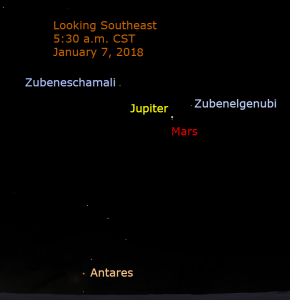
In the morning sky on January 7, 2018, Mars finally overtakes Jupiter in Libra, in an eye-opening conjunction, with Mars only 3 tenths of a degree separated from Jupiter. The Jupiter–Mars union of January 7th 2018 takes place after the first of 3 unions Jupiter will undergo in Libra, this time about 1/2 a degree apart from Libra’s brightest star– Zuben El-genubi. December 21st 2017, finds Jupiter in direct motion passing North of Libra’s alpha star, meaning “the purchase or price which is deficient.“5 Jupiter’s union with this bright star in Libra speaks to man’s inability to redeem himself, because he has been weighed in the balances and found wanting.
Plate 3. 12/21/2017 union of Jupiter-Zuben El Genubi in Libra, with Mars near Spica. 6
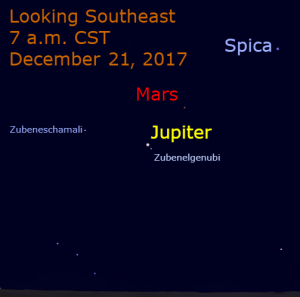
The significance of Libra not only refers to the perfect sacrifice of Jesus Christ, but also includes the judgement of God on mankind. The ONLY way man can be weighed in the balances and NOT found wanting, is by Believing in Jesus Christ as the only begotten Son of God who bought our redemption by spilling his innocent blood at the cross, [Rom. 10:9-10]. This truth is embodied in Libra’s star, Zuben Al Chemali-the Price that Covers! 7
Jesus is the only one ever who was not only qualified, but actually laid down his life for all man-kind, which makes him the only Way of Salvation, the Alpha and Omega-the first and last way God made available for the redemption of all humanity.
To brighten our holiday season this year, we will be treated to a Christmas Day conjunction of Saturn and Venus in Sagittarius! On Dec. 25th, 2017 Venus the bright and Morning Star unites with Saturn, displaying Christ’s victory over the evil one, as seen in Sagittarius where our quickly returning Lord Jesus Christ is portrayed in triumph, conquering to conquer! Here the star picture of the mounted Archer has his arrow aimed at the red heart of the Scorpion–Antares, while the foot of Ophiuchus crushes the Scorpion’s heart underfoot. As we noted in our previous blog post, Saturn has just completed its triple union with Saiph, the star in Ophiuchus’ other foot which was stung by the Scorpion, bruising the heel of the 1st and 2nd Adams, [Gen. 3:15]. This shows Satan’s persistent evil to obstruct God’s purposes any way he can, even though he knows he is defeated. This planetary conjunction near the conqueror’s Bow, shows the deadly accuracy of our Lord’s aim [Plate 4] to destroy the works of the enemy, [I John 3:8b].
Plate 4. The Arrow of Sagittarius aimed in the Galactic Center to the Heart of the Scorpion.

Of course, this week’s Jupiter-Venus union on Nov. 13th, 2017 reminds us of the Jupiter-Venus conjunctions marking the birth of Christ, on Sept. 11th, 3 BC. With the arrival of the new born king on the scene his sufferings to fulfill the OT Law as the Passover Lamb were ahead of him, where now he is looking forward to his Glory in eternal victory, and the redemption of his purchased possession–the Church of his spiritual body. The Christmas Day conjunction of Saturn and Venus in Sagittarius, recalls the exploits of the Magi in 3-2 BC, with notable celestial activity.
Matthew 2:9
When they had heard the king, they departed; and, lo, the star, which they saw in the east, went before them, till it came and stood over where the young child was.
“According to astronomical calculations, Jupiter was not visible crossing the Meridian, the “high point” over Bethlehem from September through November of 2 BC …However by December 4 of 2 BC, Jupiter became visible at the Meridian shortly before dawn…the eclipse
shortly preceding Herod’s death occurred on January 9, 1 BC. Thus it was sometime during this five week period from December 4th to January 9th that the Magi journeyed from Jerusalem to Bethlehem and saw the star of Matt. 2:9.“8
In reference to “came and stood over” in verse 9:
“Astronomically, stars and planets are similar to the sun in that they rise in the east and set in the west. Furthermore, a star or planet is like the sun in that it will reach a high point in the sky in relation to the observer. At this point it is on the Meridian (longitude) of the observer. During the day, the sun reaches this point at noon. Consider the stars and planets in their nightly courses. They rise in the east. At some time during the night each will reach its highest point in relation to the observer, the Meridian. If this occurs in the southern sky as one is travelling south, as with the Magi travelling from Jerusalem to Bethlehem, the star would appear to come and stand over one’s destination.“9
We should recall at this juncture Jupiter’s annual activities including its retrograde motion, began on December 25th, 2 BC. Martin states: “Jupiter arrived at its ordinary time for retrogression and it became stationary among the stars. But this time something unusual happened. In 2 BC as viewed from Jerusalem, Jupiter came to its normal stationary position directly over Bethlehem on December 25th…not only that, the planet assumed its stationary position while in the middle of the Constellation of Virgo, the Virgin.“ 10
Thus, according to Martin, the same astronomical phenomena that initiated Jupiter’s three Conjunctions with Regulus, its annual retrograde motion would have caused Jupiter to stand still in the heavens for about six days near the intersection of the ecliptic and the Meridian mid-body in Virgo. This occurred in week of the celebration of the Feast of Dedication in December of 2 BC. Also recall the relationship between the cycles of the Sun and Jupiter, and that the Sun, mid-bodied in Virgo for the twenty-day period, from August 27th to September 15th, marked the birth of the promised seed.
Martin goes on to say that: “on December 25th, 2 BC at the ordinary time for the Magi’s pre-dawn observations, Jupiter would have been seen in Meridian position (directly over Bethlehem) at an elevation of 68 degrees above the southern horizon. This precise position would show the planet shining directly down on Bethlehem while it was stationary among the stars.” 11
Martin’s assertion that Jupiter began its retrograde motion on December 25th, 2 BC, aligns with the start of the Feast of Dedication, that year which was from December 22 to 29. As the Magi left Jerusalem, they saw Jupiter on its nightly course. Looking south they saw it high in the sky, nearing its apex on the Meridian of Jerusalem and Bethlehem. Thus, the king planet-Jupiter was clothing Virgo, as the Sun did during the birth of the promised seed, mirroring the movement of the light of the world, while clearly marking the birthplace of the King of the Jews for the Magi.
Plate 5. The Journey of the Magi (1894) by James Jaques Joseph Tissot “12
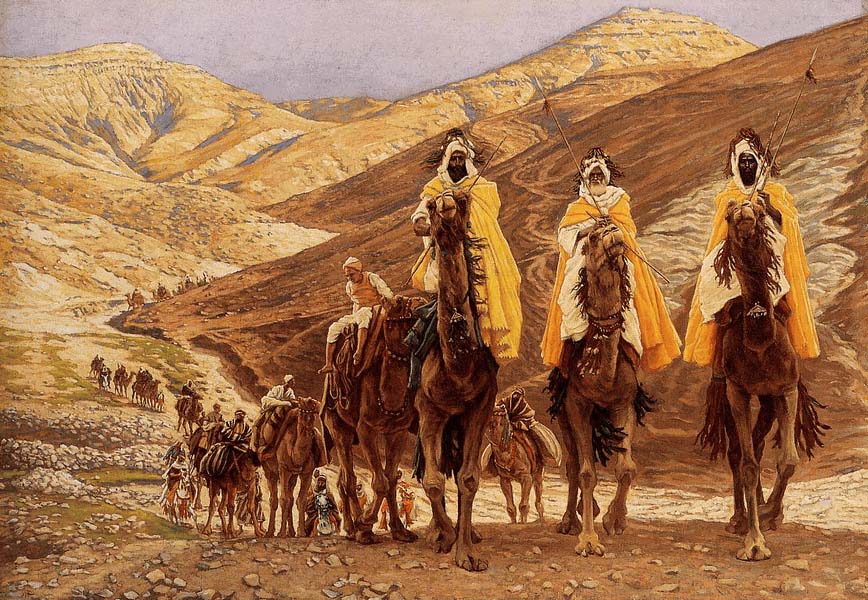
These were important celestial indicators for the Magi, who would have seen the spiritual significance of “his star”—Jupiter, in” Virgo during the month of December in 2 BC, directly over Bethlehem, indicating the birthplace of the King of Kings, who would inherit David’s throne. In this light, we can understand Balaam’s great prophecy in Numbers 24, as a reference to this.
Num. 24:17-I shall see him, but not now: I shall behold him, but not nigh, there shall come a star out of Jacob, and a sceptre shall rise out of Israel, and he shall smite the corners of Moab, and destroy all the children of Sheth.
“Star out of Jacob and a sceptre shall rise out of Israel“- Star = H3556 (kowkab) figuratively an illustrious Prince who is the star to rise out of Jacob, holding the scepter as ruler over Israel. 13 We should note the figure of speech polysyndetyn utilized in this verse regarding the “many ands” which emphasize each aspect of the verse appearing between the “ands.” This “star” was associated with the sceptre rising out of Israel, is a celestial reference to the sign of Leo the Lion with specific implications for it’s brightest luminary, Regulus the king star, the brightest star on the ecliptic also known as the “heart of the Lion.” The King’s sceptre is the symbol of his power over the heathens and those who oppose his purposes, by which he will rule over them with an unbending authority or “rod of iron,” [Ps. 2, Rev. 19:15]. Regulus was known by the ancients as the only king star which is linked with this scepter. This fulfills Jacob’s prophesy, that one holding this scepter would arise out of Judah according to Genesis 49. Secondly, the regal authority of this star is established in the king planet-Jupiter, whose authority as we have just seen, was symbolized by Leo the Lion, of the tribe of Judah that provided the regal stock from which the kingly line of Israel arose, first in King David, and ultimately in Jesus Christ from the “root of David” [Rev. 5:5]. The triple planetary Conjunction of the king planet Jupiter, with the king star Regulus in Leo from 3-2 BC, thus aligns specifically with the prophecy of Genesis 49:8-10, which shows the maturation of the Lion of the Tribe of Judah. Balaam’s revelation here in Numbers 24:17 provides a Scriptural basis for the connection between the “star of Jacob” [Jupiter] and the “Sceptre,” to the advent of Christ the King, who came forth out of Jacob’s genealogical line. Secondly, there is a celestial double meaning in the phrase: Star out of Jacob, with connotations for both the general and specific aspects of our Celestial Prelude. The complete details of the correlation between the triple Conjunction of Jupiter and Regulus in 3-2 BC, and the record in Gen. 49, is available through our bookstore on the DVD “The Biblical Astronomy of the Birth of Christ.” This unique teaching provides the in-depth instruction on the celestial pageantry of the birth of Christ, along with the history of the Magi and numerous related Biblical Astronomy topics that time does not allow in this blog post.
As we have shown, the ecliptic is structured so that each of the 12 primary signs of the zodiac of 30 degrees has three decans associated with them, of 10 degrees each. The first decan of Virgo called Coma, is depicted in the Dendera zodiac as a seated mother nourishing her infant son. Coma is the Hebrew name of this Constellation which means “the desired.” The Egyptian name for this decan of Virgo was Shes-nu the desired son, [Hagg. 2:7].14 It was in the head of this child, the desired of the nations, as Haggai prophesied him to be, that a supernova appeared over 100 years prior to the birth of Christ. E.W. Bullinger refers below, to the popular belief regarding this general sign that was prevalent in and before the first century BC:
“a traditional prophecy well known in the East, carefully preserved and handed down, that a new star would appear in this sign [Coma] when he whom it foretold, would be born.” 15
Plate 6. Jupiter-Saturn triple Conjunction of 7 BC.
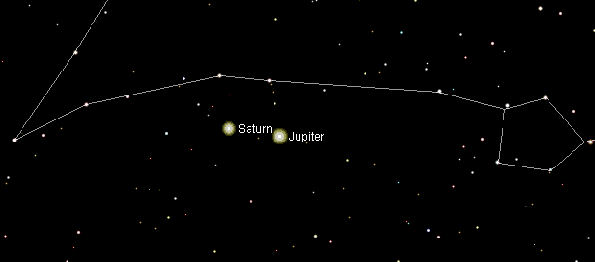
This tradition was based on Balaam’s declaration in Numbers 24, meaning that Balaam’s prophecy holds additional import. First, The new star, or supernova located in the head of the infant in Coma, visible for a total of over 270 years, was the general sign that prepared the Magi to be on watch for specific aspects of the second part of the Celestial Prelude, involving the series of celestial signs from 7-5 BC. These signs seen in the triple planetary Conjunction of Jupiter-Saturn in 7 BC would set the stage for the Magi’s recognition of the triple planetary union of Jupiter-Regulus from 3-2 BC, marking the long prophesied birth of the promised seed. Here we see the third aspect of Balaam’s prophecy in relation to the scepter, symbolic of the reign of the king planet Jupiter. As we have seen in our study, Jupiter is the planet that the Magi called “his Star” in Matt. 2:2.
“there shall come a star out of Jacob“- In Numbers 24:17, when “Jacob” is referred to, it refers not only to his seed, but also the land that was promised to him, in his Covenant with God. Bullinger states in reference to this star in Numbers 24:17 that the word “come” is, come forth (as in the Revised Version). He translates “there shall come a Star out of Jacob,” as: “There shall come forth a star at or over the inheritance or possessions of Jacob,” thus indicating the locality which would be on the Meridian of this star.”16 [emphasis mine]
This “Star out of Jacob” would not only be unique in its Messianic symbolism, of the Promised Seed, but also because of the terrestrial link of his birthplace-Bethlehem of Judea, in the Promised Land of Jacob’s inheritance. This holy land, especially the town of Bethlehem, was specifically marked out by his star-Jupiter, as God guided the Magi to the birthplace of both David and Christ. Rolleston has an notable remark regarding this:
“The Magi forewarned that the star must appear over Jacob, over his inheritance, would see that star in Coma passing over the center of that inheritance: but as it would also appear to pass vertically over every part of it that was nearly in the Latitude of Jerusalem, thus they could not at once fix on the spot of the Messiah’s birth, therefore they went to inquire; the Latitude, as it were, being given by the star, the longitude by the prophecy.” 17
Rolleston’s quote reveals that she also fell victim to the confusion between the general and specific signs of the Celestial Prelude. It was not the new star in Coma that led the Magi to Bethlehem, which had been shining brightly for over 100 years, but the Scepter–Jupiter in Virgo stationary due to its retrograde motion during the winter Solstice that stood over Bethlehem, the inheritance of Jacob, that inspired the great joy of the Magi. It was the dual triple Conjunctions of Jupiter-Saturn that identified the king planet as “His Star,” and the same star that got them started on their caravan which led them to Jerusalem in August of 3 BC. Since Coma is the “L”-shaped decan of Virgo, pictured below, adjacent to the Woman in the heavens, the Magi saw both the supernova in Coma, AND Jupiter in Virgo, simultaneously aligned on the Meridian in the same part of the skies over Bethlehem. We have depicted this graphically in the banner of this blog post.
Plate 6. Coma an ancient Decan of Virgo
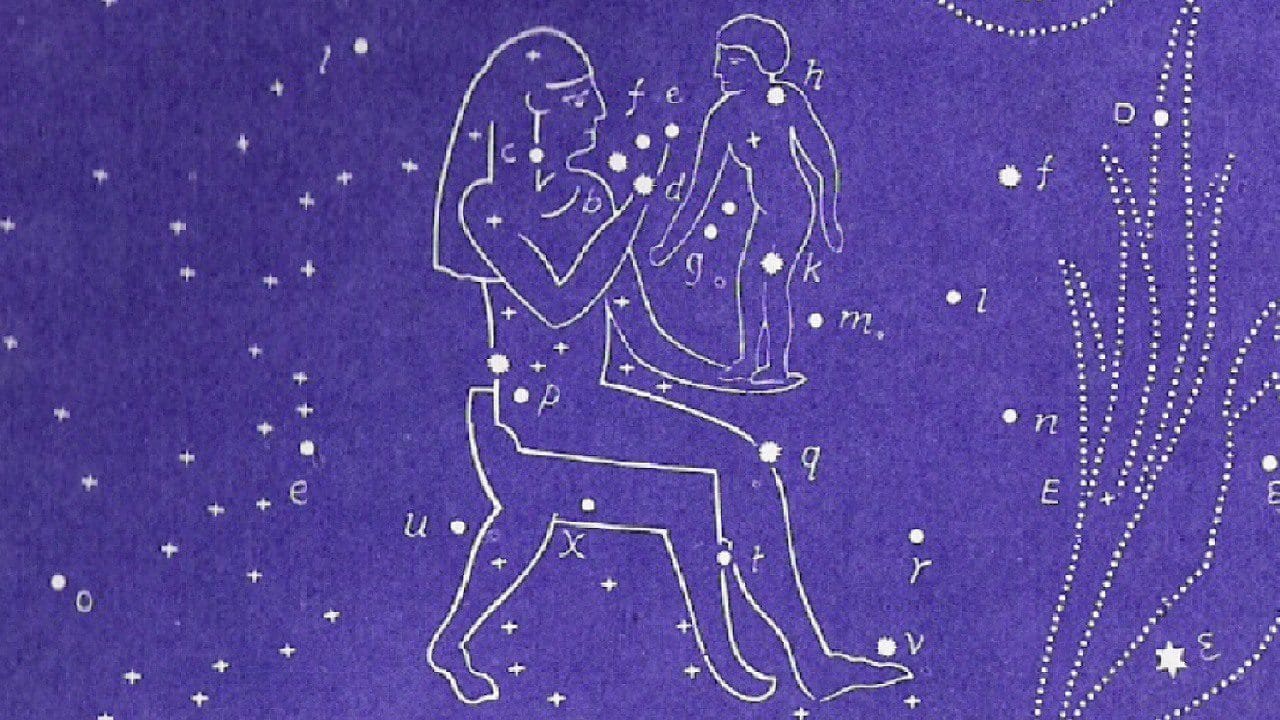
Here we see the Witness of the Stars, and the Scriptures, working together to bring the Magi to the toddler Jesus, because their alert observation of “his star” brought them to Jerusalem and the scribe’s declaration from Micah 5:2, when Herod questioned them, sent the Magi south towards Bethlehem. Tracking again the historical references to the Coma supernova, Ignatius, one of the Church Fathers and the Bishop of Antioch, in about 69 AD, records that: “At the appearance of the Lord a star shone forth brighter than all other stars.” If we are careful not to confuse this reference with the planet Jupiter, we can deduce that this supernova was still visible to Ignatius over 200 years after it first appeared, thus marking the general time-frame of Jesus’ birth. Joseph Seiss has some viable historical references which narrow down the period wherein this supernova was visible:
“Hipparchus about one hundred twenty-five years before Christ, observed it [the Coma supernova] as a new star, and was led by it to draw up his catalog of stars. Ptolemy, about one hundred and fifty years after Christ, refers to it as having been observed by Hipparchus, but as having become so faint as hardly to be any longer distinguishable.” 18
A point of interest here regarding Hipparchus is that he is generally credited with the discovery of the precession of the equinoxes by modern science in about 134 BC. He reportedly came upon this discovery while studying the star Spica, on a celestial map produced by his predecessor, Timocharis. He noticed that Spica was about 2 degrees away from it’s location on the star map, and decided that its movement averaged one degree every 75 years; [close to the actual 72 years]. This is a key to remember in our study of Dendera’s zodiac related to Spica, and this general sign detailed in other sections of our [www.try-god.com] website. Rolleston also records the appearance of this bright new star in 125 BC, so bright that it was visible during the day.
The Magi would have witnessed both this star shining brightly in Coma, in the head of the young desired son, seen as already standing on his mother’s lap, not as an infant in a manger, [Plate 7]. Just below Coma in Virgo, Jupiter was in retrograde motion standing still on the Meridian, on December 25th during their early morning observations around 4:25 am in 2 BC, Jupiter was standing high overhead, directly above Bethlehem, as the Magi approached from Jerusalem, the general sign in harmony with the specific. This gives another reason why the Magi were the only group to recognize the specific signs of the Messiah’s birth, because the general sign was a fixture in Coma from about 128 BC to 150 AD, marking the general period the Promised Seed would appear. The typical person wouldn’t have noticed any irregularity in the heavens, because it does not stand out unless coupled with the knowledge of the specific signs, regarding Jupiter, which brought the Magi to Israel in the first place. This is another reason why the Magi were overjoyed when they saw “his star” over Bethlehem. Also of interest, is the truth that the Gentile Magi arrived during Hannukah-the festival of lights, also recognized as the second Feast of Tabernacles in Israel, allowed for those who missed the first one in September. It is fitting that the initial Gentile recognition and response to the light of the world took place during this appropriate time, indicating God’s Grace to all mankind, [Hag. 2:7]. The timing of the winter Solstice is also key here because the Gentile Magi appeared at the time of the expected birth of the heathen sun-god, but honored the true Son of God instead, marking a much needed transition from the world’s idol practices, to the true veneration of the Promised Seed-Jesus Christ. This understanding of the distinction between the general and specific signs surrounding the birth of Christ should clear up the majority of the confusion and controversy related to this topic of study, if the Bible is recognized as the standard of truth, supported by history and the accuracy of the Biblical Astronomy as detailed here.
With both Mars and Venus in Ophiuchus, during this sign in December of 2 BC, we can see the archangel Mars-Michael, standing to protect the ascendant Morning star-the toddler Jesus Christ, during this time of the enemy’s attack. A noteworthy point here is Jupiter standing still in the heavens for about six days during the Hanukkah celebration, near the intersection of the ecliptic and the Meridian in Virgo. This focuses our attention on the path of Jupiter intersecting the ecliptic; the Sun’s path, pointing out the celestial relationship between Jupiter and the Sun, not to mention their kindred symbolism.
Martin states that:
… while Jupiter was in its “standing still” position over Bethlehem, the Sun was also “standing still.” All know that December 25th is in the usual period of the Winter Solstice. The word Solstice means “Sun stands still.” These stationary coincidences of Jupiter and the Sun are quite related, and would have appeared significant… 19
Plate 7. Sunset Horizon from Jerusalem at Christ’s birth on 9-11-3 BC.
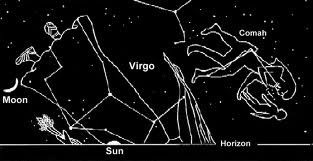
Malachi 4:2
But unto you that fear my name shall the Sun of righteousness arise with healing in his wings; and ye shall go forth, and grow up as calves of the stall.
The word “arise” in verse 2, is not only used of the Sun and light in general, but it and two of it’s derivatives occur in [Isaiah 60:1-3, Jer. 23:5]. As we have seen in regards to Jer. 23:5, the planet Jupiter, the sedeq planet is associated with the Messiah, Jesus Christ the righteous zemach-branch, and is one of five primary Old Testament prophecies pertaining to this Branch, as the coming promised seed. However, with the stationary choreography of Jupiter and the Sun, we have an added Messianic-solar link. The reference of “arise” above, is very interesting when considered not only from the aspect of Jupiter standing still, in Virgo, but also referring to the zemach-branch and the setting time of the star Spica in Virgo, whose ancient Hebrew star name refers to the four-fold ministry of Christ seen in the four Gospels. Thus it serves as a singular celestial marker of the moment of Christ’s birth, following on the heels between the setting Sun and New Crescent Moon at Virgo’s feet, [Plate 7] during the first moments of Tishri 1, in 3 BC! Thus, Virgo set the context for both Jupiter standing still on the Meridian as a reference to Bethlehem, the birth-place of Jesus Christ, and the star-set of Spica in reference to Jesus’ birth-time, at the beginning of New Year’s day, Tishri 1, on Israel’s Calendar.
This scenario provides us with the exact moments of the birth of Christ, about 20 minutes after sunset, with the setting of the Star Spica, coinciding with the first appearance of the Crescent New Moon on the first of Tishri, the newly born king was manifested to his earthly parents Mary and Joseph. Fifteen months later in Dec. 2 BC, the Magi paid their visit and homage to the toddler Jesus, imparting their gifts unto the young king, which would finance the impending trip of the royal family to Egypt, and away from Herod.
With this year’s Christmas conjunction we are reminded of our Lord’s 1st Advent, but even more we see his quick and victorious Return for the redeeming of the Church of his spiritual body, that we may ever enjoy our victory with him and the Heavenly Father.
Amen!
Footnotes
1. Starry Night Pro, Astronomy Software on Jupiter-Venus union of Nov. 13th, 2017.
2. Bruce McClure in “Tonight” for Plate 1 picture credit.
3. Starry Night Pro, Astronomy Software on the triple union dates of Jupiter-Zuben El Genubi in Libra, 2017-18.
4. Picture credit on Plate 2: https://jeffreylhunt.wordpress.com/2017/09/30/2017-2018
5. Witness of the Stars, E.W. Bullinger p. 45
6. Picture credit on Plate 3: https://jeffreylhunt.wordpress.com/2017/09/30/2017-2018
7. Witness of the Stars, E.W. Bullinger p. 46
8. Jesus Christ Our Promised Seed, p. 235. American Christian Press
9. IBID p. 234.
10. THE STAR THAT ASTONISHED THE WORLD, Dr. Earnest Martin p. 49.
11. Ibid
12. Picture credit on Plate 5; The Journey of the Magi (1894) by James Jaques Joseph Tissot
13. Strong’s Concordance on H3556, James Strong.
14. Witness of the Stars, E.W. Bullinger
15. The Witness of the Stars, E.W. Bullinger ppg. 36-37.
16. IBID footnote p.37
17. The Mazzaroth, Frances Rolleston. Footnote on “The Star of Bethlehem.”
18. The Gospel in the Stars, Joseph Seiss, p. 161.
19. THE STAR THAT ASTONISHED THE WORLD, Dr. Earnest Martin. p. 60.